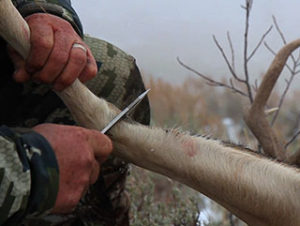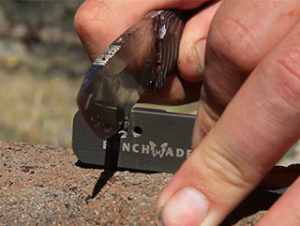Knives come in all different shapes and sizes. For instance, kitchen knives have clear applications. Serrated kitchen knives are for bread, boning knives are for separating meat from bone, fat, and silver skin, chef’s knives are for chopping. Every day carry knives (EDC) like your grandfather’s old pocket folder or an updated assisted opening folder with a pocket clip have purposes that are mostly utilitarian. Tactical knives feature completely different blade shapes that are suited for the military and law enforcement. The same goes for hunting knives.
The cutting edge does the work but the shape of the knife determines how it puts that edge to the subject. Just like other knives, hunting knives have shapes that are designed to do certain jobs better than others. In the field, you are normally limited to one or maybe two knives. They have to do multiple jobs and also fit weight and size requirements to be ideal at their specific tasks.
Benchmade Knife Company builds knives for the most demanding customers, from special operations forces to elite backcountry hunters, and building for the best requires the best raw materials. #TheHuntingPages Knife expert Carlton Schumacher shares his expertise in the latest Seminar Series Video Blade Shapes! Hunting
Posted by Hunting on Friday, August 11, 2017
Blade Style
Blade style describes the overall type of blade shape. Drop point and clip point are the two major styles of blades used as hunting knives. This is where the confusion for some might begin. Although these are actual blade styles, they can be different in their application depending on the width and length of the blade.
Drop Point– Take for example, Benchmade’s Saddle Mountain Hunter and Saddle Mountain Skinner. Both are from the ultra-premium Hunt series with best in class S30V steel and both are classified as drop points. Drop point is the shape in which the back or spine of the knife starts straight then “drops” to a point. This mostly describes a style of blade but the reality is that the cutting edge does the work. So, if a drop point knife is very lean and narrow it has a different purpose than if it has a large “belly” or rounded shape to the cutting edge.
The Saddle Mountain hunter is an 8.5-inch knife with a drop point that would be classified as a “traditional” blade shape. Traditional in that it has stood the test of time and if it needed to be changed it already would have been. It is a multiuse knife for most field applications and an excellent choice if you are using it in hunting and general outdoor applications. 
Another drop point knife is the Saddle Mountain Skinner. It is the same length, steel, and handle style as the Saddle Mountain Hunter but the cutting edge is different which makes it excel at skinning. It is also a multiuse knife but the cutting edge also known as the “belly” of the blade is rounded and the tip of the blade is not pronounced. This is key when you are separating the skin from the animal, as long smooth cuts are required. As hunters know, it is imperative not to puncture the skin, which causes hair or contaminates to get onto the meat.
Clip Point– The other famous blade style is the clip point. It is called the clip point because the back “spine” of the blade starts straight then the blade is “clipped” off to make the point of the knife more pronounced. This blade shape has a cutting edge which is rounded for skinning and multiuse and a pronounced point which is perfect for the detailed cuts required for capeing your trophy. A great example of this blade is Benchmade’s Crooked River in their Hunt series. This knife matched form and function because it is a contemporary folder with a very versatile blade shape. It is ideally suited for the new generation of hunters who are interested in being portable and possibly multiuse as an everyday carry option.
The are other examples of knives that share traits of each but become more specialized. For example, the Nestucca Cleaver from Benchmade has a long sweeping “belly” to the blade which excels at large game skinning. It is based on a traditional Alaskan knife called an Ulu. This wouldn’t be your choice for caping an animal or small game but if you were going on a moose hunt, this would be a star. Another example is the Benchmade’s Hidden Canyon Hunter. This fixed blade is a little over 6 inches in total, so it is compact but has a rounded “belly” like a skinning knife with and a nice point for more detailed cuts. This combines a compact size with all the features of a larger knife. This is perfect for a pack-in elk or sheep trip where portability is at a premium.
The right blade shape makes all of the difference in how a knife performs in the field. The way you hunt and the game you pursue should dictate the blade choice you should make. It is worth noting that you can have the perfect blade shape for the task but cheap steel won’t keep the edge long enough for the knife to excel. In the knife world, as in most things, you get what you pay for. This knowledge ahead of time can bring some clarity to your next hunting knife purchase. https://www.benchmade.com/



















![The Best Deer Camp Chili [VIDEO] Deer Chili Ingredients, Tomatoes, Chili Spices](/wp-content/uploads/2015/10/Deer-Chili-Deer-Camp-Recipe-218x150.jpg)
![How to Call Elk Early in the Season [VIDEO]](/wp-content/uploads/2016/08/byers003-218x150.jpg)




![Idiots Disturb Hunter: How Would You Have Handled It? [VIDEO]](/wp-content/uploads/2015/10/DSC00110-e1474487693878-100x70.jpg)
![Albino Buck Shocked to Shed His Antlers [VIDEO]](/wp-content/uploads/2015/10/AlbinoDeer-100x70.jpg)